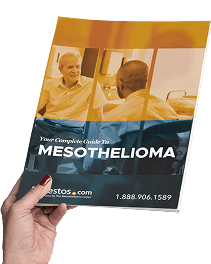Webinar Recap: Asbestos Exposure Proof in Mesothelioma Cases
Legislation & LitigationWritten by Travis Rodgers | Edited By Amy Edel

We recently hosted an exclusive online webinar with experts in building strong mesothelioma legal cases. Our panelists shared important insights from their own professional experience helping people with mesothelioma prove their asbestos exposure.
Webinar participants were able to ask questions and gain insights into the process of working with an experienced mesothelioma lawyer to pinpoint when, where and how they were exposed to asbestos. Our panel of experts for the event included top mesothelioma attorney Carl Money and Danielle DiPietro, a board-certified financial advocate and Patient Advocate at The Mesothelioma Center.
Moderator and panelist Danielle DiPietro has more than a decade of experience guiding people through the financial challenges a mesothelioma diagnosis can bring. Danielle helps survivors and their families access the best resources to help them.
Carl Money has been helping people with mesothelioma for nearly 20 years. He’s recognized as a leader in asbestos litigation, sharing his insights and experience globally in presentations about seeking justice for those who became seriously ill because of asbestos.
How to Prove Your Asbestos Exposure
Our panelists opened the webinar with a discussion of evidence needed to prove your asbestos exposure. Imaging scans like CT scans, your pathology report and documentation of your work history are key pieces of evidence.
Speaking to the importance of medical evidence, Danielle explained, “You would start with going to a pulmonologist, which is a lung specialist who can do an X-ray, given your history of exposure. You would go through your health insurance. If you don’t have health insurance, you can contact our Patient Advocates.”
Common Types of Evidence for Proving Exposure
- Asbestos products you worked with
- Employment records
- Government reports
- Medical records
- Military service records
- Pathology report
- Past litigation records
- Witness testimony
As Carl Money said, gathering records from your past is typically the first step to building a solid case. He explained, “First thing is we’re going to get an understanding of your work history.”
“The evidence we’ll gather includes your social security records, your military records,” Money noted. “You’d get any and every record of your work life and figure out your exposure.”
As our panelists explained, you may encounter challenges when building your asbestos case. For example, your state’s statute of limitations can present a challenge. It sets a time limit on when you can file your claim. This gives you limited time to gather evidence before the deadline to file. However, as Money said, your mesothelioma lawyer will manage the evidence gathering and legal processes for you, ensuring you have everything you need and your claim is filed correctly and on time.
“The challenges will be overcome by the attorneys,” Money emphasized. “Mesothelioma is caused by one thing and that’s asbestos exposure. You have mesothelioma because you’ve breathed asbestos into your lungs so we have to figure out how you breathed that asbestos into your lungs.”
Your Law Firm’s Role & Tracing Your Exposure
Money shared the initial steps of working with a mesothelioma law firm. He explained, “What would happen is I would come to your house. We would go through a contract, then we would just walk through your life.”
He said he’d go through as many details as possible “From the day you’re born until the day I’m sitting in your living room.” This will help narrow down when and where your asbestos exposure happened.
“We would figure out all of the places where you breathed asbestos,” he added. “You don’t need to worry so much about it because we’ll get all of that evidence.”
Tracing back your exposure begins with reviewing your work and military history. Your attorney will be able to identify any asbestos-containing products you may have produced, worked with or been around extensively.
They’ll talk to your former co-workers who can attest to what your role was and the products you were exposed to or used in the performance of your job. They’ll also check asbestos databases for information that can help you.
He also shared how an experienced attorney can identify the asbestos exposure of deceased loved ones. Money explained a similar approach is used. Your lawyer will interview family members, friends and former co-workers. They’ll review employment records and military records.
Additionally, your lawyer can help those exposed as a result of secondary asbestos exposure. They can verify who had primary exposure and how you were then exposed to the fibers they inadvertently brought home on their clothing, hair, skin or gear.

Our experts share key tips for building a successful mesothelioma compensation case during this free recording of a webinar for mesothelioma patients and families.
Get a RecordingLegal Timelines & Options When Your Company Is Out of Business
Money also explained your case’s timeline may vary depending on the type of claim you’re filing. The specific legal process in the jurisdiction where your claim will be filed also plays a role.
“We could file the case in the first few weeks, because once you file a case you’ll have timelines in the court system to pressure the defendants to either pay money or tell us why their products made you sick,” Money shared. “Depending on what kind of case it is, a trial case could take a lot longer 6 months or a year or more.”
He also explained how your timeline may be impacted if the company responsible for your asbestos exposure has declared bankruptcy. He noted, “If it’s a bankruptcy only case we could get money to you within 3 months or so.”
Understanding Traditional vs. Non-Traditional Exposure & Your First Steps
Our webinar panelists then addressed traditional ways people are exposed to asbestos compared to non-traditional exposure. Traditional asbestos exposure includes military exposure and occupational exposure.
Non-traditional exposure includes environmental asbestos exposure or exposure to asbestos products in old buildings, home construction materials or home appliances. DIY mechanics, people with secondary exposure and people who used products containing asbestos-contaminated talcum powder are also examples of people with non-traditional exposure.
Following a mesothelioma diagnosis, there are some important steps you need to take if you want to begin building a successful case. The best way to begin is speaking with a Patient Advocate who can guide you through all of the steps along your journey.
Steps to Take After a Mesothelioma Diagnosis
- Contact a Patient Advocate to identify the best law firm for your case.
- Set up a meeting with a top asbestos lawyer to discuss your life story.
- Your attorney will file your claim in the proper jurisdiction and naming the appropriate defendants.
- Settlement negotiations will likely begin with your lawyer working for the compensation you need on your behalf.
Some patients may hesitate to file a lawsuit because they’re concerned about appearing in court. Money says it’s not always necessary.
“Patients don’t have to go to court,” Money explains. “If the case goes all the way to trial and we still have a few defendants left, it might be good but it’s a discussion that the attorney and the family will have.”
Learn about your diagnosis, top doctors and paying for treatment.
Get Your Free GuideDoctor-reviewed, ships overnight for free







